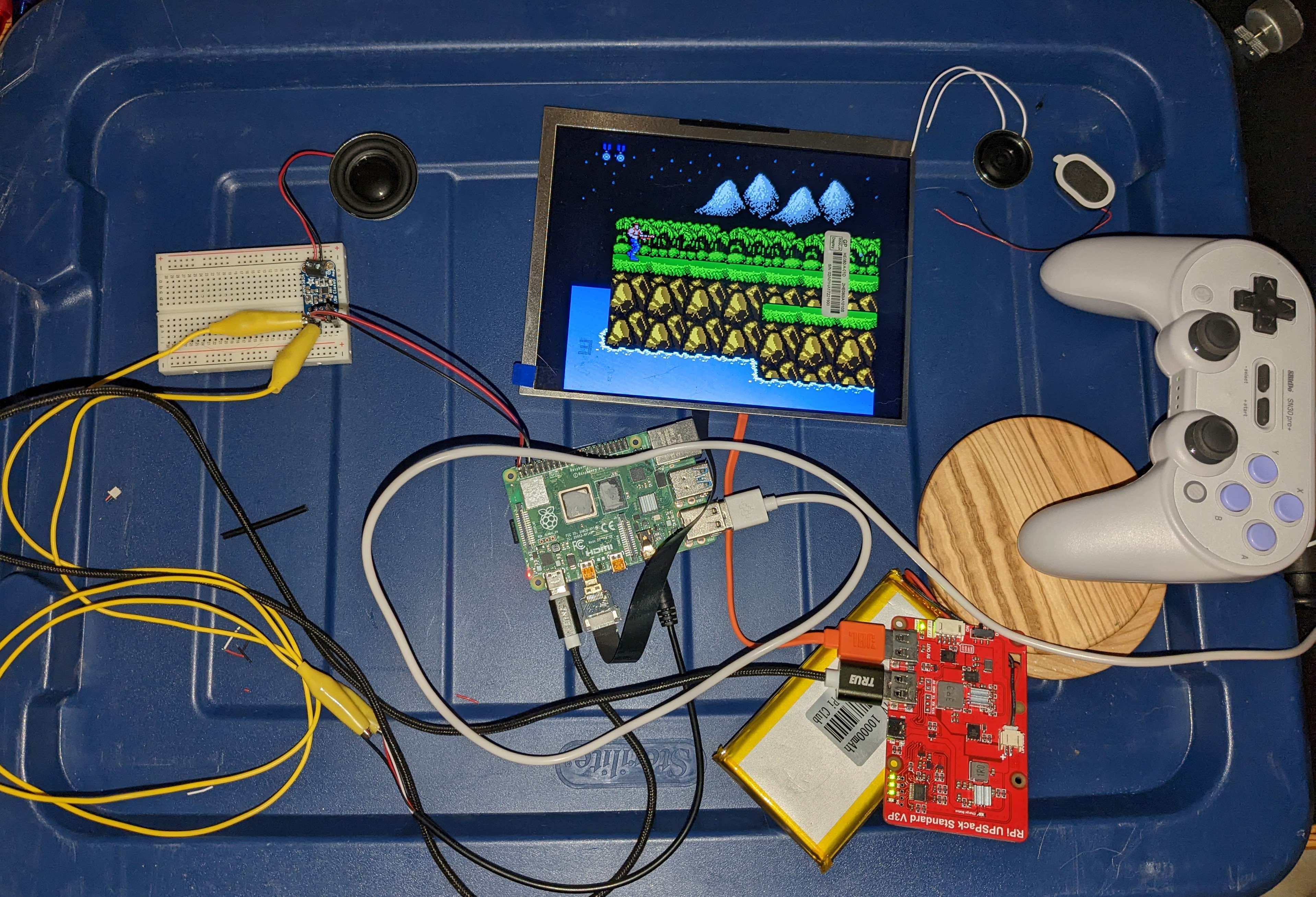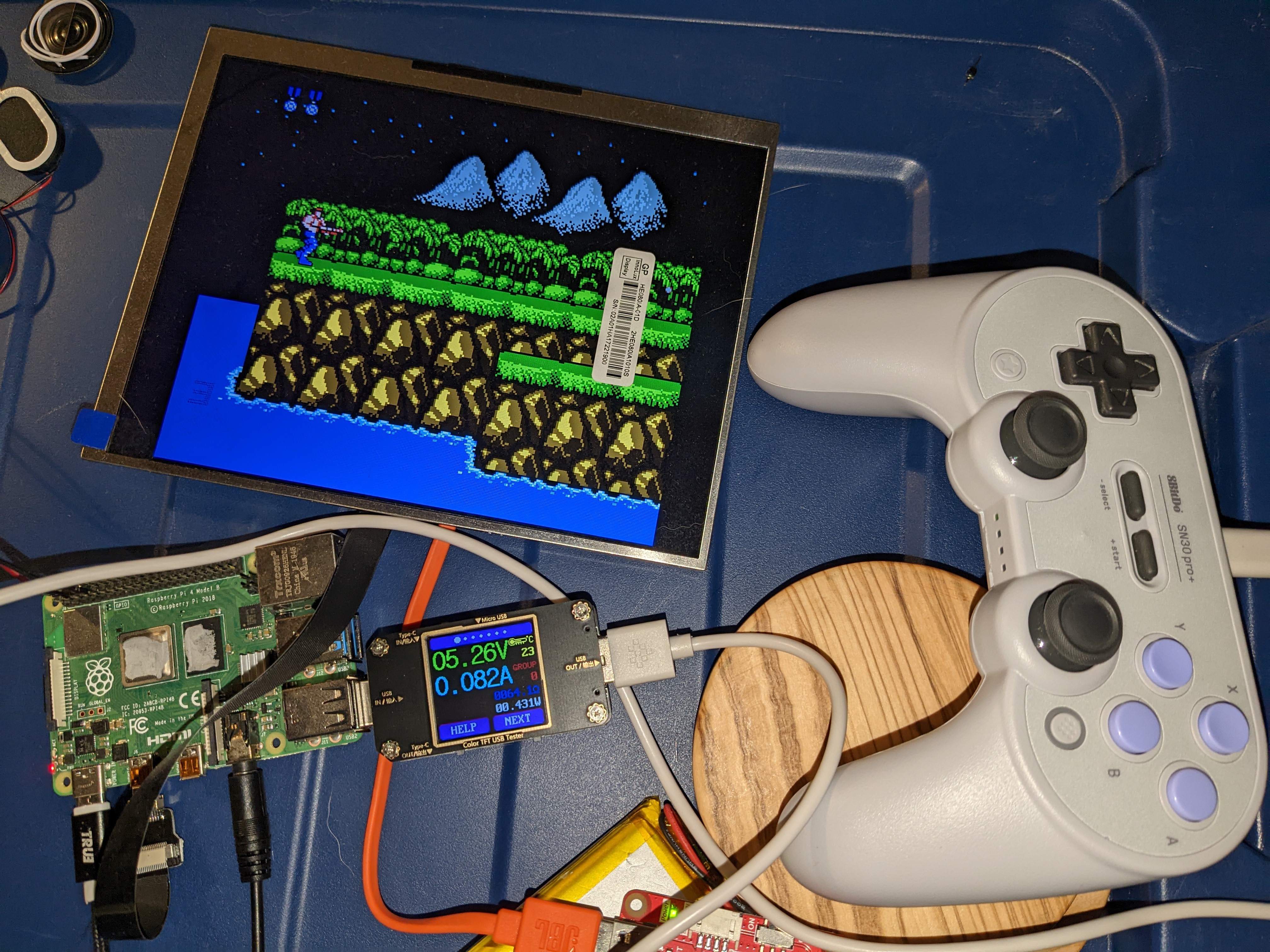Test Results
Individual Component Power Consumption
| Raspberry Pi 4 | ~580-700mA |
| Raspberry Pi Zero W | ### |
| 8" Display and Driver Board (35%, 50%, 75%, 100% Brightness) | ~425, 490, 610, 750mA |
| 5" Display and Driver Board (50%, 75%, 100% Brightness) | ### |
| 8Bitdo Controller (using currently)*** | ~40mA |
| TeensyLC Controller (will use in final system)*** | ### |
| Mono Amplifier w/ 3W Speaker*** | ~8-20mA |
| Fan Style 1 | ~35mA |
| Fan Style 2 | ~170mA |
| WIFI disabled | ### |
| Headphone Jack*** | ### |
| Bluetooth Headphones*** | ### |
| Total of Currently Used Components | ### |
***Note: component powered by Raspberry Pi
Battery Runtime Test #1 (Rpi4, 8" display @100% bright, 3W audio, 8Bitdo ctrl, NES emulator running)
| Indicator LED Description | Capacity Calc | Total Runtime (min) | Total Runtime (H:MM) | Lap Time (H:MM) |
| 4 LEDs lit | 100% | 0 | 0:00 | 0:00 |
| 3 LEDs lit | 95% | 12 | 0:12 | 0:12 |
| 2 LEDs lit | 64% | 92 | 1:32 | 1:20 |
| 1 LED lit | 32% | 173 | 2:53 | 1:21 |
| 1 LED blinking | 24% | 194 | 3:14 | 0:21 |
| Power Down | 0% | 256 | 4:16 | 1:02 |
Battery Runtime Test #2 (Rpi4, 8" display @50% bright, 3W audio, 8Bitdo ctrl, NES emulator running)
| Indicator LED Description | Capacity Calc | Total Runtime (min) | Total Runtime (H:MM) | Lap Time (H:MM) |
| 4 LEDs lit | 100% | 0 | 0:00 | 0:00 |
| 3 LEDs lit | 84% | 49 | 0:49 | 0:49 |
| 2 LEDs lit | 56% | 140 | 2:20 | 1:31 |
| 1 LED lit | 32% | 216 | 3:36 | 1:16 |
| 1 LED blinking | 26% | 234 | 3:54 | 0:18 |
| Power Down | 0 | 316 | 5:16 | 1:22 |
[10-18-2022]
I finally received the replacement battery charger PCB and have a fully charged battery! This means that it's feasible for me to power the console back on. I've got a little USB power meter that will allow some measurements to be taken on the individual components in the console. These measurements aren't strictly necessary, but are really just for the curiosity of it. And I'm especially curious how the measured power stacks up against the 10,000mAh battery and what kind of runtime I'll get. From my limited experience with batteries, I believe that the rating is referencing the total energy capability of the battery. And because the system will need to be shutdown before all the energy is discharged (@ about 3.5V), this means the entire rated mAh isn't usable energy and the "effective" battery rating will be lower than 10,000mAh.
Here's a picture of the console guts with an 8Bitdo controller instead of the final TeensyLC controller. Also note from this picture that I am testing out speakers and the amplifier board right now and will create a separate log for that process.

And here is a picture showing the USB power meter connected to the controller USB cable. I tried to take the highest consistent peak that I was seeing from the meter when creating the table below.

And finally, here is a table listing the power consumption for each component. For components powered by the Raspberry Pi, I first took a base measurement of the RPi without anything connected to it. Then I took a measurement with the component attached and subtracted the base measurement.
[11-27-2022]
So, I had originally thought that measuring the power consumption of each component in this project was unnecessary and only served to satisfy my curiosity. However, after actually making some of the measurements, the process actually highlighted a couple areas of concern.
First of all, my testing process wasn't the best and was causing the measurements to be weirdly low. I was measuring power with the components connected to the battery, and started noticing the Rpi throwing out a low voltage warning. I have a suspicion that the battery charger board has a high-ish output impedance, and I'll plan on investigating it at some point. This also prompted me to find an alternative battery charger for comparison. And after measuring the power consumption of components while connected to outlets instead of battery, the measurements shot up closer to values I was expecting.
The second area of concern is the battery life. From the testing I have done, the battery life has been abysmal. To the point that if I can't find a way to improve it, this project may be dead in the water. I haven't tested it well yet, but it seems like I'm only getting about 2 hours of play time out of the 10,000mAh battery at this point. This prompted me to find an alternative 5" display and to dig out my Raspberry Pi Zero W so that I can test their power consumption as well. I'm hoping that these measurements help me see any areas of improvement.
And finally, I have updated the table of measurements in the previous post with new values.
[12-04-2022]
I have moved the table of power measurements to the top of this post and have also added a couple tables documenting results from some tests that I completed this week. The tests were to simply fully charge the battery and run the system until it powered off to see how long it would last. I ran the test twice, once with the screen at 100% brightness and once at 50% brightness. The process and results are documented more below.
Given the doubts that I had about the battery/charger board in previous posts, my expectations with this test were pretty low. And the results are pleasantly surprising! The punchline is that the battery lasted for 4:16 (H:MM) with the display at 100% brightness, and 5:16 at 50% brightness.
There were two misunderstandings that I uncovered which previously made the battery life seem poor. One is that I wasn't fully charging the battery. The incorrect assumption that led to this was that if all 4 battery level LEDs were on, that the battery was 100% charged. This isn't correct, and the 4th level indication LED will turn on much earlier than full charge. Like, somewhere between 1 and 2 hours prior to full charge. The correct way to determine full charge is to pay attention to the charging status LED. This LED blinks when charging and then turns solid when done charging.
The other misunderstanding was what it means when the last of the level indication LEDs starts blinking. I assumed that this meant power down is eminent and so I would power off or switch to non-battery power. But after running these tests, it looks like the battery has roughly an hour of runtime after the indicator starts blinking. Looking at the testing results in the tables at the top, it just seems to me that the time going from 4 LEDs down to 2 is non-intuitive compared to the actual runtime of the system. My takeaway is that with 2 LEDs, the battery is just above 50% capacity. And when the 1st LED starts blinking, then there is roughly an hour left on the battery.
An interesting exercise is to compare the tested battery discharge time to an estimated theoretical value. I'm estimating from the table at the top that the Rpi4 and 8" display use 1,140mA at 50% brightness, and 1,400mA at 100% brightness.
10,000mAh @ 3.7Vdc = 37,000mWh
37,000mWh = 7,400mAh @ 5Vdc0
0.8 * (7,400mAh / 1,140mA) = 5.2hr (50% brightness)
0.8 * (7,400mAh / 1,400mA) = 4.2hr (100% brightness)
This theoretical calculation actually matches the tests very well. Notice that I applied an 80% factor in the last step. This accounts for unused capacity left in the battery at the point that the charger board shuts it off. My surface level understanding of this is simply that the 10,000mAh rating of the battery represents the total energy stored. In order to use all this energy, the voltage would have to be run down to or close to 0V. And since the charger board shuts the battery off around 3.3V the entire battery capacity is not utilized. I have no idea if an 80% utilization factor makes sense, but it seems reasonable.
I'd still like to test out the current draw and battery discharge times of my Pi Zero W paired with a 5" display, but have misplaced the HDMI adapter needed for the Pi Zero W. The 5" display will also need a custom cable made to power it, so I'll save this for another time.
Discussions
Become a Hackaday.io Member
Create an account to leave a comment. Already have an account? Log In.